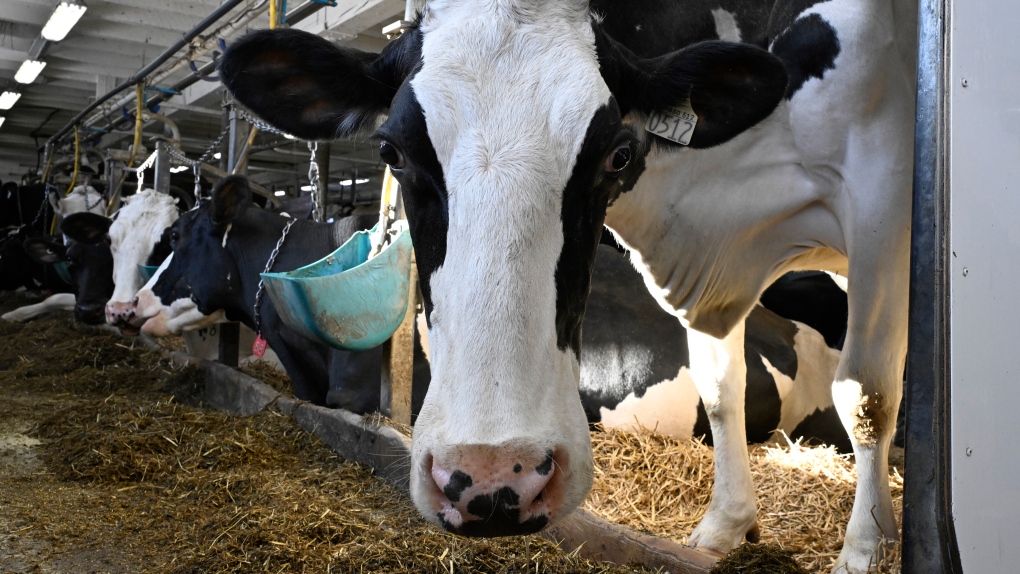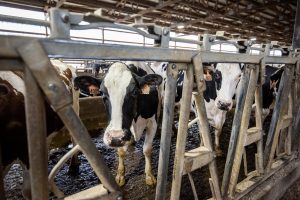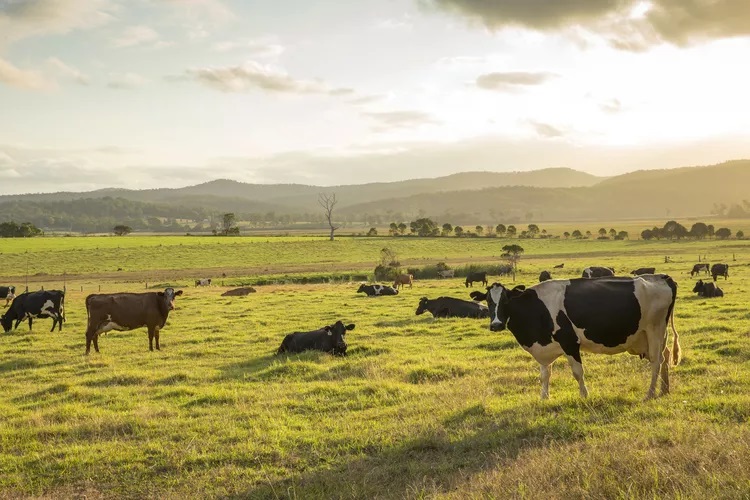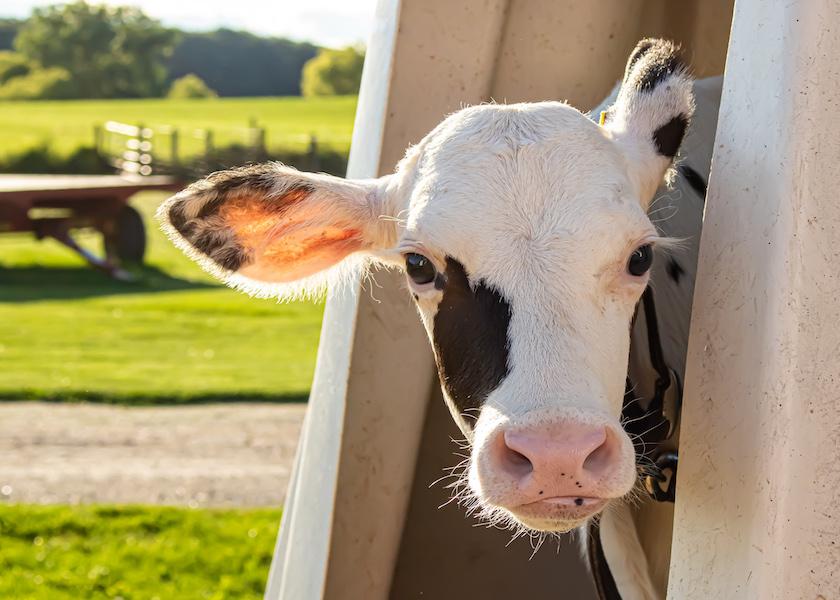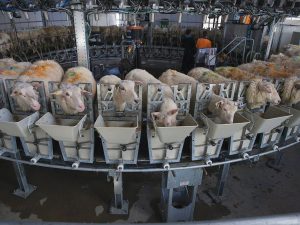The dairy industry remains captivated by the diagnosis of highly pathogenic avian influenza (HPAI), now confirmed by USDA on dairy farms in Kansas, Texas, Michigan, New Mexico, Ohio and Idaho. Analysis is underway for additional presumptive positive tests from herds in Kansas, New Mexico, Ohio and Texas.
One case has been confirmed in Idaho, three in Kansas, one in Michigan, two in New Mexico, one in Ohio and seven in Texas. Restrictions on dairy cattle movement are in place in Delaware, Idaho, Nebraska, Tennessee and Utah.
The National Milk Producers Federation stated, “There continues to be no concern about the safety of the milk supply or that this circumstance poses a risk to consumer health because products are pasteurized before entering the market, per the Food and Drug Administration. Only milk from healthy animals is authorized for distribution into interstate commerce for human consumption. Additionally, pasteurization has continually proven to inactivate bacteria and viruses, including influenza, in milk.”
The U.S. Center for Disease Control and Prevention (CDC) announced last Monday that a person in Texas tested positive for avian influenza after exposure to dairy cattle presumed to be infected with the H5N1 bird flu: “The patient reported eye redness as their only symptom, and is recovering.”
The U.S. human risk assessment remains low. However, the CDC said, “People with close or prolonged, unprotected exposures to infected birds or other animals (including livestock), or to environments contaminated by infected birds or other animals, are at greater risk of infection.”
HighGround Dairy reports that this is actually the second person to have tested positive for influenza A (H5N1) viruses in the U.S. A previous case occurred in 2022 in Colorado. The CDC noted that “human infections of avian influenza are uncommon but have occurred sporadically worldwide.”
Speaking in the April 8 “Dairy Radio Now” broadcast, StoneX broker Dave Kurzawski said no one knows what impact this outbreak will have on the market but says we have some historical reference. He said Christmas Eve 2003, Mad Cow disease, BSE, was first reported in dairy cows in Washington State and “The cattle markets broke hard over it and the price of cheese went from $1.30 per pound to $2.20 in April, four months later because other things mattered more.”
“When the U.S. consumer hears cattle, they think beef,” he reasoned. “They don’t necessarily think milk on their cereal or cheese on their pizza but it’s early in this ongoing situation.”
He does not think it will matter much for dairy demand.
If it spreads the impact would be more on the supply side, he said, because cows produce less milk as they get sick, some do not bounce back, some even die. The markets may be concerned about it but he doesn’t see it as a long term problem.
“Short of putting a giant net over the dairy to keep birds out,” Kurzawski said, “there’s probably not a lot more that can be done, other than what farmers are already doing, such as washing equipment and trucks more thoroughly.”
The March federal order Class III milk price was announced at $16.34 per hundredweight, up 26 cents from February but $1.76 below March 2023. The three-month average stands at $15.86, down from $18.44 at this time a year ago and $21.25 in 2022.
Class III futures remain disturbing. The April contract was trading last Friday morning at $15.55; May, $16.36; June, $16.93; July, $17.42; August, $17.97; September, $18.22; October, $18.30; November, $18.20; and December $17.91.
The March Class IV price is $20.09, up 24 cents from February, $1.71 above a year ago, and the highest since November 2023. Its three-month average is at $19.78, up from $19.08 a year ago, but compares to $23.97 in 2022.
Dairy margins deteriorated further the last half of March as milk prices continued to move lower while feed costs held steady, according to the latest Margin Watch (MW) from Chicago-based Commodity and Ingredient Hedging LLC.
The MW stated, “While USDA’s latest monthly Milk Production report reflected a continued trend of declining output, the Cold Storage report was negative for cheese inventories which has kept pressure on that market and Class III milk futures. USDA reported February milk production at 18.1 billion pounds, down 1.3% from a year ago after adjusting for this year’s leap day. February marked the eighth consecutive monthly decline from year-ago comparisons, and the largest monthly production decline year-over-year since January 2022.
“January’s milk output was also further revised down to reflect a 1.2% decline from 2023, with February’s dairy cow herd at 9.33 million head down 89,000 from last year but up 10,000 from January’s revised estimate. February’s monthly increase in the milking cow herd was the largest in nearly a year and may suggest the economics of cow retention have started to shift for some operations.”
The MW also detailed the Avian Influenza outbreak and stated, “Increased biosecurity measures will limit heifer movement and the culling of unproductive animals may further tighten supply.”
Most cash dairy prices start April higher as traders try to anticipate the effects of the influenza outbreak. The CME Cheddar blocks closed last Friday at $1.5150 per pound, up 9.75 cents on the week, highest since March 4, but are still 31.50 cents below a year ago, as traders awaited Friday afternoon’s February Dairy Products report.
The Cheddar barrels finished at $1.53, 10.25 cents higher, 19 cents below a year ago, and 1.50 cents above the blocks. There were 42 loads of block traded on the week, highest since the week of June 26, 2023, and 29 of barrel.
Midwest cheesemakers tell Dairy Market News that milk is widely available, which is expected in the early spring season and just after a holiday weekend.
Early week spot milk prices were not as low, nor as high, as the previous week but within the range $5- to $3-under Class III. Cheesemakers say plant downtime, along with the holiday weekend, added milk availability but “There are more questions from contacts regarding near-term milk availability than answers,” says DMN. Last year spot prices ranged from $11- to $3-under class.
Manufacturers report cheese production is strong in the West. Milk volume is plentiful due to the season and spring breaks cycling through the region. Industry participants convey strong to steady cheese demand. Demand from pizza makers has strengthened this year compared to the prior year, says DMN.
Butter closed last Friday at $2.94 per pound, highest CME price since Nov. 6, 2023’s $3.01, up 9.75 cents on the week and 62.25 cents above a year ago on 33 sales.
Butter makers in the Upper Midwest say demand has held somewhat steady with recent weeks. Year-over-year sales, both prior to and just following the holiday, were a bit lower than last years. Food service demand is following the same pattern. Cream remains widely accessible. That said, some of the sub-1 multiples from the previous week were not reported this week. Some Central butter makers have cream deliveries locked in through the rest of April. Butter markets continue to meet or beat expectations, says DMN.
Butter makers convey strong to steady production in the West as they build inventories for fourth quarter ahead of summer churn maintenance. Domestic butter demand is strong to steady following the recent shorter holiday week.
Grade A nonfat dry milk closed the week at $1.1325 per pound, up 1.25 cents and 75 cents above a year ago, with 12 sales reported on the week.
Dry whey saw its Friday finish at 39 cents per pound, down 1.25 cents on the week but 2.50 cents above a year ago, with four sales on the board for the week.
The week ending March 23 saw 57,600 dairy cows go to slaughter, up 200 from the previous week, but 8,600, or 13%, below a year ago. Year to date, 691,100 head have been culled, down 113,600, or 14.1%, from a year ago.
U.S. dairy exports topped those of a year ago for the first time in a year, according to the USDA’s latest data. Sailings totaled 483.8 million pounds, adjusted for leap year, up 5.5% from February 2023, and set a monthly record. HighGround Dairy credited increased sales to Mexico, up 4.5%, and up 20% to Southeast Asia, though exports to China were down 24%.
Cheese exports totaled 95.6 million pounds, up 27.3% from a year ago, up for the fourth consecutive month and the largest since June 2022. HGD said, “Given the average Cold Storage data for February, the firm export number would suggest that domestic demand was pretty poor. This surge is primarily attributed to massive shipments to Mexico, which totaled 36.6 million pounds and set a new monthly record.” HGD pointed out that Cheddar exports rebounded after a year of decline and hit their highest level since January 2023.
Nonfat dry milk and skim milk powder sailings hit 148.9 million pounds, up 3.4%, despite reports of weak demand. Exports to Mexico were down, however Southeast Asia saw imports jump 39%. Volumes also rose to Indonesia, Vietnam, Malaysia and Thailand.
Butter exports totaled just 5.1 million pounds, down 35.3%. HGD says the February’s sales likely reflect bookings made as butter prices declined from their record-high levels in fall 2023. Butter imports were up 32.6%, largest volume since March 2023, and the third-highest on record, according to HGD.
Whey exports were down 5.7%, due to reduced shipments to China “where the hog sector is continuing to experience difficulties and demand for feed-grade products remains sluggish,” said HGD. “Whey protein concentrates saw an uptick in both categories however reflecting sustained strong demand worldwide”
Trading looked a little brighter in Tuesday’s Global Dairy Trade Auction which saw the weighted average regain the 2.8% it dropped on March 19. Traders brought 41.3 million pounds of product to market, down from 43.3 million on March 19, and the lowest since May 19, 2020. The average metric ton price climbed to $3,558, up from $3,497 on March 19.
Cheddar led the gains, up 4.1% after dropping 1.9% on March 19. Whole milk powder followed, up 3.4%, after dropping 4.2%. Skim milk powder was up 1.4%, after a 4.8% descent. Butter was up 3.1%, after slipping 1.4% last time, and anhydrous milkfat was up 2.3%, following a 2.5% rise. Lactose was down 3.1%, after dropping 4.4% last time, and buttermilk powder was off .5%.
StoneX says the GDT 80% butterfat butter price equates to $2.9171 per pound, up 8.1 cents from March 19, and compares to CME butter which closed last Friday at $2.94. GDT Cheddar, at $1.9685, was up 6.7 cents, and compares to last Friday’s CME block Cheddar at $1.5150. GDT skim milk powder averaged $1.1568 per pound, up from $1.1417, and whole milk powder averaged $1.4726 per pound, up from $1.4258. CME Grade A nonfat dry milk closed last Friday at $1.1325 per pound.
“North Asia purchases, which includes China, were stronger than the previous GDT event but weaker than year-ago levels,” said analyst Dustin Winston. “Southeast Asia purchases were reduced from both the last event and last year’s levels.”
“The big takeaway was the increase in interest from the Middle East and Europe,” he said, “where purchase volume increased from both the last GDT event and last year. Middle East purchases tend to be strong in the second half of Ramadan, and this is in line with that trend.”
Cooperatives Working Together member cooperatives accepted 29 offers of export assistance last week that helped capture sales of 2.5 million pounds of American-type cheese, 309,000 pounds of butter, 454,000 pounds of anhydrous milkfat, 628,000 pounds of whole milk powder and 600,000 pounds of cream cheese. The product is going to customers in Asia, Central America, the Caribbean, Middle East-North Africa and Oceania through August.
In politics, the National Milk Producers Federation submitted its final, formal legal “brief” on their behalf for Federal Milk Marketing Order (FMMO) modernization to USDA. The NMPF brief, which was submitted March 29 emphasized that “Those farmers are the reason the system exists and that, by law, their priorities are pre-eminent in USDA consideration of a final plan.”
“Our proposed package of proposals to the Federal Milk Marketing Order align thoroughly with its mission and purpose, which were intended to put farmers first,” said Gregg Doud, president and CEO of NMPF. “We’ve spent nearly three years painstakingly assembling the broad consensus among dairy farmers that modernization needs to succeed. Our approach is careful and comprehensive, and it benefits farmers of all regions and types of operations.”
Meanwhile the International Dairy Foods Assn. (IDFA) reports that USDA is expected to soon release a final rule revising the Special Supplemental Nutrition Program for Women, Infants and Children (WIC) food package. “With it, the food and nutrition benefits of nearly 6 million mothers and children under the age of 5 are at risk of being cut,” warns the IDFA.
You can now read the most important #news on #eDairyNews #Whatsapp channels!!!
🇺🇸 eDairy News INGLÊS: https://whatsapp.com/channel/0029VaKsjzGDTkJyIN6hcP1K

